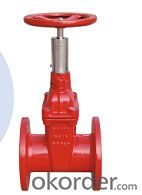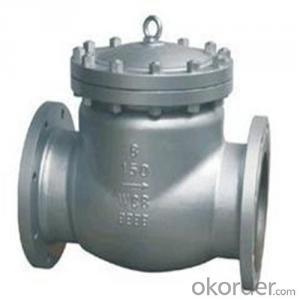Gate Valve with Brass Isolating Valve Good Price
- Loading Port:
- China main port
- Payment Terms:
- TT or LC
- Min Order Qty:
- 1000 set
- Supply Capability:
- 80000 set/month
OKorder Service Pledge
OKorder Financial Service
You Might Also Like
1. Structure of Gate Valve Description:
1. Selected materials, in line with domestic and international standards, high overall quality of the material.
2. In line with the requirements of domestic and foreign advanced standards, reliable sealing, excellent performance, attractive appearance.
3. Sealing pair advanced and reasonable, gate and seat sealing surface with different hardness Stellite (Stellite) cobalt-based alloy cladding made, reliable sealing, high hardness, wear resistance, high temperature, corrosion good anti-abrasion performance, long life.
4. Stem quenched and nitride surface treatment, has good corrosion resistance, scratch resistance and abrasion resistance.
5. The use of flexible wedge gate structure, medium and large caliber set thrust bearings, friction force is small, and with a striking manually open and close with ease.
2. Main Features of the Gate Valve:
Working medium: water, non-corrosive liquid, saturated vapor (≤ 0.6MPa)
Operating temperature: -20 °C ≤ t ≤ 135 °C
Stem: non-rising stem
Body material:Brass/Stainless Steel
Connection:flanged
3. Images of the Gate Valve:


4. Specification of the Gate Valve:
1) Product information: the gate valves supplied are mainly used for adjusting water, steam, oil, gas, and natural gas in chemical industries
2) Standards: AWWA, DIN3352 F4/F5, BS5163, BS5150
3) Connection type: flanged type, push-on type, mechanical joint type, plain ends type
4) Design and Manufacture:API602,BS5352,ANSI B16.34
5) Connection Ends:
1)Socket Welded Dimension:ANSI B16.11,JB/T1751
2)Screw Ends Dimension:ANSI B1.20,JB/T7306
3)Butt Welded:ANSI B16.25
4)Flanged Ends:ANSI B16.5,JB79
6) Test and Inspection:API598,GB/T13927,JB/T9092
5.FAQ
1. Can I get free samples?
A: Yes,we can provide you the free sample, but you need to bear their own delivery costs.
2. Can I request to change the form of packaging and transportation?
A:Yes, We can change the form of the packaging and transportation according to your request, but you have to bear their own costs incurred during this period and the spreads.
3. Can I have my own Logo on the product?
A: Yes, you can send us your drawing and we can make your logo, but you have to bear
their own the cost.
4. Can you produce the products according to my own drawings?
A:Yes,we can produce the products according to your drawings that will be most satisfy you.
- Q: Bought a 1986 GMC 350day 1 started up good - idle was rough - idle really too low, when brakes where applied, it would backfire. (day 2) Changed oil which was really dark - oil filter too... ghanged spark plugs and wires. % 10 improvement... Engine lack power and vibrates but no more backfire.day 4 Changed Cap and rotor - % 30 improvement - day 5 Got the manifold gasket replaced. Same condition but silent... day 6 Changed coil in cap ... Changed fuel filter % 60 improvement... The thing ran like new... Full power I started beliving again..Got full oil pressure 300 kpa - no valve noise Ran 30 minutes on highway.... Valves started making noise especially on driver's side... Engine lost lots of power, and vibrates a lot... doesnt heat up to much but oil pressure seems very low. (day 7) Start up the thing, and even when cold and choke on, oil pressure not as good as in the beginning. What went wrong
- What went wrong? Bought a 1986 GMC 350. Solution? (day 8) buy a Ford
- Q: Is this possible? The valve is way too big to fit the rim. Is there a special inner tube for this rim? Thanks in advance.
- Sounds as if you need a tube with a Presta valve stem vs. a Schrader valve stem. Link below showing the difference.
- Q: overrun clutch solenoid valve dtc definitions code P1760
- Description The overrun clutch solenoid valve is activated by the TCM in response to signals sent from the park/neutral position (PNP) switch, overdrive control switch, vehicle speed and throttle position Will then be controlled. TCM TERMINALS AND REFERENCE VALUE ON BOARD DIAGNOSIS LOGIC Diagnostic trouble code O/R CLTCH SOL/CIRC with CONSULT-II or P1760 without CONSULT-II is detected when TCM detects an improper voltage drop when it tries to operate the solenoid valve. POSSIBLE CAUSE Check the following items. Harness or connectors (The solenoid circuit is open or shorted.) Overrun clutch solenoid valve DIAGNOSTIC TROUBLE CODE (DTC) CONFIRMATION PROCEDURE CAUTION: Always drive vehicle at a safe speed. NOTE: If DIAGNOSTIC TROUBLE CODE CONFIRMATION PROCEDURE has been previously conducted, always turn ignition switch OFF and wait at least 5 seconds before conducting the next test. TESTING CONDITION: Always drive vehicle on a level road to improve accuracy of test. After the repair, perform the following procedure to confirm the malfunction is eliminated. WITH CONSULT-II Turn ignition switch ON and select DATA MONITOR mode for `ENGINE with CONSULT-II. Start engine. Accelerate vehicle to a speed of more than 10 km/h (6 MPH) with D position (O/D ON). Release accelerator pedal completely with D position (O/D OFF). WITH GST Follow the procedure With CONSULT-II. WIRING DIAGRAM - AT - ORVCSV Diagnostic Procedure 1: CHECK VALVE RESISTANCE 2: CHECK VALVE OPERATION 3: CHECK POWER SOURCE CIRCUIT 4: CHECK DTC 5: CHECK TCM INSPECTION This isn't something you want to do in your driveway. Take it to a decent mechanic and they should have it knocked out in about an hour or less, if it's the same one I'm thinking of.
- Q: Hi, I was told by my gardener that I need new sprinkler valves and each of those run about $50-70. I looked up online and I found them for $20 or less. Also what is the basic labor cost for getting them installed? I got estimates that range from $300-1000. I am confused.
- they screw in and out, acouple of wrenches, a shovel, a roll of teflon tape, all less than 300$
- Q: I have been diagnosed with a bicuspid aortic valve and a discrete stenosis under the valve at 11 years old. I am now 25. My cardiologist told me I might need a valve replacement a 70. Can people actually live long with that condition? I don't understand it. And he only wants me to have an ultrasound every 3 years because nothing has changed in the past 10 years. Can my condition change in a short time? At a dangerous level? I have bad anxiety because of this.
- The mitral valve between the left atrium and left ventricle only has two cusps and it works fine. Since the valve going into the left ventricle has two valves, it stands to reason that a similar valve going out of the left ventricle would function similarly if it was the same size and shape. The number of cusps is not entirely related to how well the valve functions. In your case, the opening of the aortic valve is slightly smaller than normal, but clearly capable of passing an adequate amount of blood. The stenosis alone may be the only problem caused by the valve. The stenosis you have likely creates some back pressure when the left ventricle contracts. The heart compensates partly for the back pressure but this prolonged compensation wears on the heart valve a little more than normal. So, you end up with a heart that more or less functions normally but the back pressure and compensation cause the heart valve to wear out faster than normal. Its a gradual effect. The type of damage done from this circumstance is not something that changes rapidly. Evaluating the condition every three years is still probably a very cautious approach and its not certain that the stenosis will ever become a significant problem even if you live well beyond 70 years.
- Q: How would this affect the functioning of the heart valves?How would this be detected in a routine examination?
- If the heart valves are damaged, they may leak, causing regurgitation of blood. For example, if the mitral valve (between the left atrium and left ventricle) leaks, blood will leak back into the left atrium when the ventricle contracts. This reduces the efficiency of the heart contraction. Regurgitation is easily detected by echocardiography. On routine physical exam it may be detected *if* there is enough leakage/ flow abnormality to cause an audible sound, or murmur, that your physician can hear with his/her stethoscope.
- Q: what exactly causes a valve to stretch?
- Valves do not stretch rods do. Valves just push up in to the seat as they are used.
- Q: Ok i dont know much about cars so if anybody could help out with this id appreciate it. Do i need to take my car in to get the PCV valve replaced or can i buy it and have it done in my driveway?Thanks....
- The PCV valve is about 3 inches long, just pull it out of the valve covers and replace it with the new one!!!
- Q: Hello. I am interested in purchasing a Hydroclean Fill Valve for my toilet. Are these good fill valves? Thanks!
- who cares, a toilet fill valve only costs a few bucks. as long as it opens and closes it's a good valve. if it only lasts for a year then it's a piece of junk and you should try another brand. it's not a major decision
- Q: I have a problem with standing water that keeps puddling up and never drains under where my valves are located for my sprinklers. What do I do? Should I just put 3/4 drain rock on top? Please help?
- Sounds to me, like you have one of two things happening. Either you have a leak, which needs to be fixed. Or the valve box is in a low area where the water drains to... Turn on the water and watch the valves.. you might be able to see where the water is coming from. It may be as simple as tightening down the valve screws, or you may need to turn off the water at the main and repair or replace it. If the water is draining there or the leak isn't all that terrible the only way drain rock would help is if you were to dig underneath the valve a little, and to replace what you dig out with rock... Just make sure you can still access everything when you are finished. Good Luck!
Send your message to us
Gate Valve with Brass Isolating Valve Good Price
- Loading Port:
- China main port
- Payment Terms:
- TT or LC
- Min Order Qty:
- 1000 set
- Supply Capability:
- 80000 set/month
OKorder Service Pledge
OKorder Financial Service
Similar products
Hot products
Hot Searches
Related keywords


























